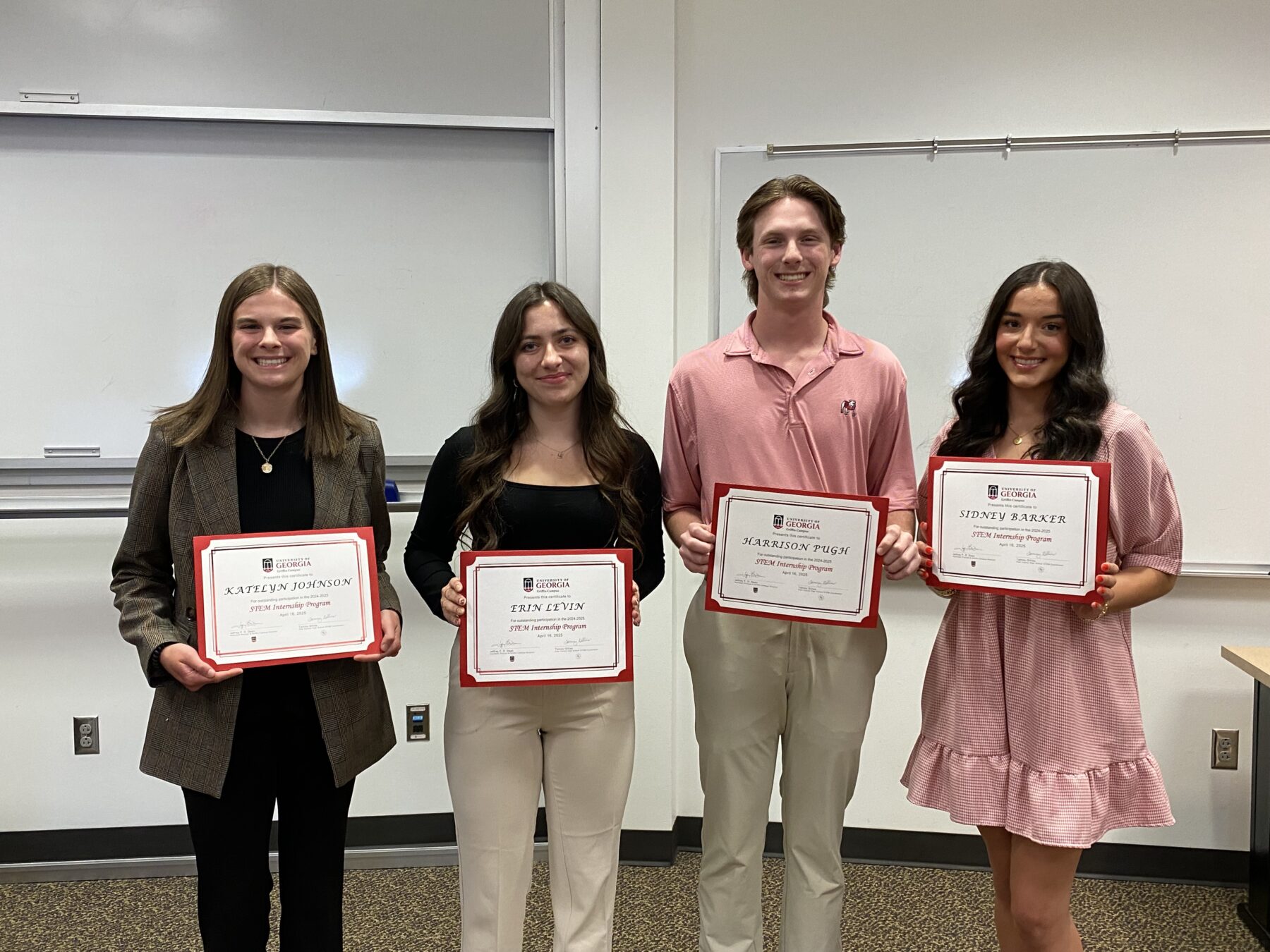
Congratulations are in order for four Pike County High School seniors who recently completed the University of Georgia Griffin Campus STEM Internship Program for the 2024-2025 school year. The students- Sidney Barker, Erin Levin, Katelyn Johnson and Harrison Pugh- spent the school year conducting research on the Griffin campus under the guidance of faculty mentors in exchange for academic credit.
The UGA Griffin Campus STEM Internship Program is done in collaboration with the Pike County STEM Academy, the first agriculture focused STEM Program in the state. The partnership began in 2017 and is designed to prepare high school seniors for post-secondary education and future careers in the STEM field. Students participate in unpaid internships on campus where they complete 100 hours of research each semester and give an oral presentation on their work in the fall and spring.
During the Spring presentations, held on April 16 on the Griffin campus, each student spoke about the research they did for the semester.
Sidney Barker worked with Dario Chavez and his team doing peach research in the horticulture department. Her project for the semester focused on peach tree architecture, specifically how changing the structure of the tree could allow for automation in harvesting the fruit. She stated in changing the trees to a 2-D shape would not only decrease labor costs, but also allow more sunlight to reach all parts of the tree. This would increase the health and quality of the fruit along with the amount produced. The majority of her research included scanning the trees with a Faro 360 camera to study their phenotypic traits, such as the number of branches which lay the groundwork for future genomic studies and trails to determine if the trees work in a 2D system.
Erin Levin spent the semester also working in peach research with Dario Chavez and his team. Her work focused on helping with on-going research trials that are experimenting with different treatments to help peaches break or extend dormancy. If a successful method is found, it could allow farmers the opportunity to determine the most optimal time for peaches to break dormancy which would enable the trees to potentially produce more fruit for better harvests. Another aspect of her work included breeding peaches where she was able to select the parent tree and hand-pollinate the flowers. In doing this it allows for desirable traits, such as sweeter fruit, bigger fruit or disease resistance, to be passed on to the offspring. She noted both aspects of her project not only help to produce better peaches, but also to give farmers more control over their crops for improved harvests.
Katelyn Johnson was assigned to work at the Food Product Innovation and Commercialization (FoodPIC) Center with James Gratzek and his team. For her project, she completed a centralized location test (CLT) on pecan log candy for a FoodPIC client. A CLT is a type of quantitative research where participants are invited to interact with products or services and provide feedback. For her test, Johnson invited participants to sample four different varieties of pecan logs to gather data about the nougat texture of each and determine which type consumers preferred. Doing a study like this helped to show the client that while they were happy with the product, consumer feedback suggests there are still improvements that could be made, which would help the client in the marketing and sale of their item.
Harrison Pugh worked in the department of plant pathology in Bochra Bahri’s lab, where his work centered on the preservation and molecular identification of fungi. On part of his project was to determine if fungi can be effectively preserved for long-term use in the lab. Pugh used two different methods- the filter paper method, which is viable for two to three years, and the microbank method, which is viable for five to 10 years, to preserve the samples. Preserving the samples correctly is essential for long-term studies and identification. The second part of his research was to learn how to accurately identify fungal species using molecular biology techniques such as a polymerase chain reaction (PCR) a technique used to amplify a certain gene sequence from an unknown fungal sample. Once he was able to isolate the gene sequence, the PCR products were sent off for DNA sequencing where the next step would be to use an online tool to compare our sequence with known fungi and identify the species — like matching a fingerprint to a database. The identified fungi are used for research such as pathogenicity tests, studying growth patterns, genetic studies, drug discovery, and biotechnology applications.
As the STEM program closed for the year, the four seniors are in the process of finishing their remaining month at Pike County High School and then following graduation they are all off to college in the fall. Sidney Barker will attend UGA to study biochemistry and molecular biology. Erin Levin will pursue a degree in animal biosciences with a pre-veterinary track at UGA. Katelyn Johnson will attend Georgia Tech to study material science and engineering. Harrison Pugh will attend UGA to study agribusiness and pre-law. UGA Griffin is excited to continue the partnership with Pike County High School and will welcome the ninth group of STEM interns to campus in the fall.
